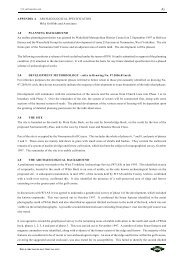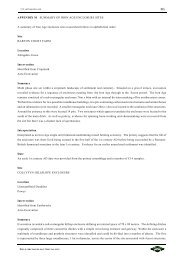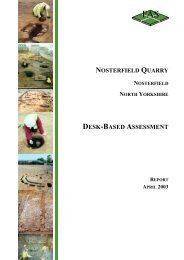ARCHAEOLOGICAL EVALUATION - Mike Griffiths and Associates
ARCHAEOLOGICAL EVALUATION - Mike Griffiths and Associates
ARCHAEOLOGICAL EVALUATION - Mike Griffiths and Associates
You also want an ePaper? Increase the reach of your titles
YUMPU automatically turns print PDFs into web optimized ePapers that Google loves.
FAS_lbf01.wpd 171<br />
as well as deposits of marl with occasional pockets of desiccated peat which is typical of the detritus filling the<br />
feature.<br />
The lithic distributions from fieldwalking <strong>and</strong> test pit excavation appear to reflect the area of prehistoric activity.<br />
The concentration of lithics detected by fieldwalking <strong>and</strong> test pit excavation corresponded with the area where<br />
Neolithic features were encountered during evaluation excavation. However, the lithic material within <strong>and</strong> on<br />
the ploughsoil does not appear to pertain directly to underlying features. Horizontally located flint could not<br />
therefore be reunited with plough-disturbed underlying archaeological features.<br />
The preservation of the late Neolithic features deserves further discussion. Feature 1 encountered within<br />
Intervention 7 allowed the first incidence of the ploughsoil-late Neolithic archaeology interface to be recorded<br />
in section. The excavation records identified substantial disturbance of the upper levels of the feature <strong>and</strong><br />
extreme subsoil dragging <strong>and</strong> turbulence. Such damage has at times been identifiable in plan at Nosterfield<br />
Quarry. The depths of the identifiable late Neolithic features at Ladybridge Farm compare poorly with those<br />
encountered during Investigation 3 at Nosterfield Quarry (FAS 2005) which tended to be better preserved <strong>and</strong><br />
subject to far less plough damage. This higher level of plough damage may offer a possible explanation for the<br />
lower density of prehistoric features in the Ladybridge Farm sample; it is clear that the Ladybridge archaeology<br />
is under severe <strong>and</strong> immediate threat from ploughing.<br />
The evaluation results suggest that the density of late Neolithic features is lower within the current area of<br />
investigation than in areas encountered previously. The total number of probable late Neolithic features<br />
encountered within the southern zones st<strong>and</strong>s at six (F1, F2, F7, F14, F16 <strong>and</strong> F17), including those dated by<br />
2<br />
lithics only, in trenches totalling 4281m . The total of identifiable features is likely to be low, however, <strong>and</strong><br />
some undated features may also prove to belong to the late Neolithic period.<br />
10.1 PALAEOENVIRONMENTAL ASSESSMENT (Dr Stephen Carter)<br />
10.1.1 Introduction<br />
The purpose of this report is to provide an assessment of the palaeoenvironmental aspects of the archaeological<br />
resource at Ladybridge Farm. The palaeoenvironmental resource is defined as all sources of information on the<br />
nature of the environment in the past. Particular emphasis is placed on evidence for human impact on the<br />
l<strong>and</strong>scape <strong>and</strong> man-environment interactions, given the archaeological context of this assessment. This<br />
information will be retained in mineral <strong>and</strong> organic sediments, deposited since the last ice age. Data-sets may<br />
include both biological materials (for example pollen, beetles or phytoliths) <strong>and</strong> properties of the actual<br />
sediments, which are the diagnostic products of chemical <strong>and</strong> physical processes.<br />
Evidence relating to the contemporary environment derived from archaeological features <strong>and</strong> deposits may be<br />
a significant resource in its own right <strong>and</strong> has been assessed (Appendix G). The scope of the present report is<br />
limited to what would be viewed by archaeologists as off-site deposits.<br />
FIELD ARCHAEOLOGY SPECIALISTS







